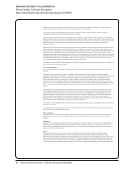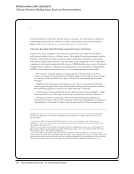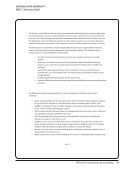SPEC Kit 337: Print Retention Decision Making · 69
This survey was extremely hard to answer as none of our activities seem to match your categories well. Our high-
density storage facility houses three million volumes. It is on our west campus—not adjacent to our facilities or our
regular classroom buildings, but is not technically “off campus.” Please feel free to move our answers accordingly. Our
high-density facility is partly state-funded and part of a state network of storage facilities although all of the materials
housed in the facility are owned by the Libraries, it is on university property and staffed by library employees. It also
houses special collections staff, offices, and their reading room. We also participate and have collections stored in the
CIC-operated Shared Print Repository at Indiana. We are in the process of bringing online “outsourced” storage as
well. That will be a contract with a vendor for storing extensive special collections in a vendor-managed facility. I don’t
know how to fit that information into your categories. Our high-density storage facility was brought online in the 1990’s
and thus it is hard to say who was involved in decision-making, etc. The communication questions are similarly hard to
answer. These activities have been normal operations for many years, if not decades. It is not necessary for us to do any
particular communications regarding them. We certainly provide information on the locations patrons see in our catalog
and explain how to request materials from our facilities. However, we offer office delivery for our collections regardless
of where they are housed, so it is relatively irrelevant whether they are in the main library or our high-density storage
facility (we scan articles as well and ship our monographs to offices).
UNC Chapel Hill shares, with Duke University Libraries, a high-density storage facility, the Library Service Center. We do
have a consortial arrangement for maintaining single copies of journal titles. We at UNC have sent more than 1.5 million
volumes into the facility and are now engaged in a long-term, more moderately paced process.
We “float” our collection among our campuses so that if a book is checked out to a patron at one campus, they can
return it to that campus and it will sit on the shelf at that campus until it is requested by someone else at another
campus.
We are about to initiate an analysis of our print monograph collections, working with an outside vendor, to support
decision-making around retention of print. Currently, we have collections housed at a commercial facility, and two
separate on-campus locations. Decision-making has been opportunistic, not strategic, to date. There is recognition of
the need to develop a strategic, selective decision-making process.
We are already a member of several resource sharing partnerships. We will continue to build on these and, hopefully,
enter into some shared collection development partnerships. Where possible we will only purchase content in e-formats.
We are increasingly interested in HathiTrust or other stable digital content providers. We have an active digitalization
and digital preservation program. And we are actively involved and interested in emerging initiatives for shared print
archiving, including in other Canadian and US-based regions and networks.
We are just beginning many of these processes. We have had off-site storage for some time, it mostly holds print
materials that we have in electronic format. We anticipate ramping up decision-making about what stays on campus,
what goes into storage, and what is deaccessioned. We are developing guidelines for these activities now and once
draft guidelines are approved, we will develop a comprehensive communication plan.
We currently purchase a very small proportion of our monographs in electronic format, but I anticipate that will increase
over time.
We have moved large (700,000+ items to one facility 400,000+ to another) active collections off-site to transform
central library floors into labs and study spaces. Off-site collection remains available in the catalog and can be requested
for next-day delivery from larger remote site and 3-day delivery from smaller site.
This survey was extremely hard to answer as none of our activities seem to match your categories well. Our high-
density storage facility houses three million volumes. It is on our west campus—not adjacent to our facilities or our
regular classroom buildings, but is not technically “off campus.” Please feel free to move our answers accordingly. Our
high-density facility is partly state-funded and part of a state network of storage facilities although all of the materials
housed in the facility are owned by the Libraries, it is on university property and staffed by library employees. It also
houses special collections staff, offices, and their reading room. We also participate and have collections stored in the
CIC-operated Shared Print Repository at Indiana. We are in the process of bringing online “outsourced” storage as
well. That will be a contract with a vendor for storing extensive special collections in a vendor-managed facility. I don’t
know how to fit that information into your categories. Our high-density storage facility was brought online in the 1990’s
and thus it is hard to say who was involved in decision-making, etc. The communication questions are similarly hard to
answer. These activities have been normal operations for many years, if not decades. It is not necessary for us to do any
particular communications regarding them. We certainly provide information on the locations patrons see in our catalog
and explain how to request materials from our facilities. However, we offer office delivery for our collections regardless
of where they are housed, so it is relatively irrelevant whether they are in the main library or our high-density storage
facility (we scan articles as well and ship our monographs to offices).
UNC Chapel Hill shares, with Duke University Libraries, a high-density storage facility, the Library Service Center. We do
have a consortial arrangement for maintaining single copies of journal titles. We at UNC have sent more than 1.5 million
volumes into the facility and are now engaged in a long-term, more moderately paced process.
We “float” our collection among our campuses so that if a book is checked out to a patron at one campus, they can
return it to that campus and it will sit on the shelf at that campus until it is requested by someone else at another
campus.
We are about to initiate an analysis of our print monograph collections, working with an outside vendor, to support
decision-making around retention of print. Currently, we have collections housed at a commercial facility, and two
separate on-campus locations. Decision-making has been opportunistic, not strategic, to date. There is recognition of
the need to develop a strategic, selective decision-making process.
We are already a member of several resource sharing partnerships. We will continue to build on these and, hopefully,
enter into some shared collection development partnerships. Where possible we will only purchase content in e-formats.
We are increasingly interested in HathiTrust or other stable digital content providers. We have an active digitalization
and digital preservation program. And we are actively involved and interested in emerging initiatives for shared print
archiving, including in other Canadian and US-based regions and networks.
We are just beginning many of these processes. We have had off-site storage for some time, it mostly holds print
materials that we have in electronic format. We anticipate ramping up decision-making about what stays on campus,
what goes into storage, and what is deaccessioned. We are developing guidelines for these activities now and once
draft guidelines are approved, we will develop a comprehensive communication plan.
We currently purchase a very small proportion of our monographs in electronic format, but I anticipate that will increase
over time.
We have moved large (700,000+ items to one facility 400,000+ to another) active collections off-site to transform
central library floors into labs and study spaces. Off-site collection remains available in the catalog and can be requested
for next-day delivery from larger remote site and 3-day delivery from smaller site.


















































































































































































































